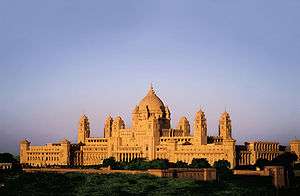Art of Rajasthan

Maru Gurjara Art (Rajasthani: मारू गुर्जर) is an ancient Rajasthani art that developed during the early sixth century period in and around Rajasthan.
| Part of a series on |
| Rajasthani people |
|---|
 |
| Culture |
| Religion |
| Language |
| Rajasthan Portal |
Etymology
The name Maru Gurjara has its genesis in the fact that during ancient times, Rajasthan and Gujarat had similarities in ethnic, cultural and political aspects of the society. Ancient name of Rajasthan was Marudesha while Gujarat was called Gurjaratra. Maru Gurjara Art literally means Art of Rajasthan and Gujarat.[1]
Historical development
During the early medieval period, perhaps early 5th century, a unique art form was taking shape in and around two areas of western India namely Marudesh and Gurjaratra (present day Rajasthan and Gujarat). During this period Marudesh and Gurjaratra saw tremendous changes in the political and cultural sphere and these changes lent a helping hand in further development of art. By the onset of seventh century; art of painting and sculpture had reached its zenith in these areas.[2]
Maru-Gurjar Painting
Colorful tradition of Rajasthanis reflects in art of paintings as well. This painting style is called Maru-Gurjar Painting. It throws light on the royal heritage of ancient Rajasthan. Under the Royal patronage various styles of paintings developed, cultivated and practiced in Rajasthan and reached its pinnacle of glory by 15th to 17th centuries. The major painting styles are phad paintings, miniature paintings, kajali paintings, gemstone paintings etc. There is incredible diversity and imaginative creativity found in Rajasthani paintings. Major schools of art are Mewar, Marwar, Kishangarh, Bundi, Kota, Jaipur and Alwar.
Development of Maru-Gurjar Painting[3]
- Western Indian Painting Style - 700 AD
- Mewar Jain Painting Style - 1250 AD
- Blend of Sultanate Maru-Gurjar Painting Style - 1550 AD
- Mewar, Marwar, Dhundar & Harothi Styles - 1585 AD
Phad paintings
Phad paintings (Mewar Style of painting) is the most ancient rajasthani art form. Phad paintings, essentially a scroll painting done on cloth, are beautiful specimen of the Rajasthani cloth paintings. These have their own styles and patterns and are very popular due to their vibrant colors and historic themes.The Phad of God Devnarayan is largest among the popular Pars in Rajasthan. The painted area of God Devnarayan Ki Phad is 170 square feet (i.e. 34' x 5').[4] Some other Pars are also prevalent in Rajasthan, but being of recent origin they are not classical in composition.[4] Another famous Par painting is Pabuji Ki Phad. Pabuji Ki Phad is painted on a 15 x 5 ft. canvas.[4] Other famous heroes of Phad paintings are Gogaji, Prithviraj Chauhan, Amar Singh Rathore etc.[5] )
Images
-
%2C_Kishangarh%2C_ca._1750%2C_National_Museum_New_Delhi.jpg)
Bani Thani painting
-

Purushkara Yantra, 18th century
-

Krishna and Radha dancing, 19th century
Notes
- ↑ Vasishtha 1995, p. 22
- ↑ Vasishtha 1995, p. 10
- ↑ Vasishtha 1995
- 1 2 3 Painted Folklore and Folklore Painters of India. Concept Publishing Company.
- ↑ Indian Murals and Paintings By Nayanthara S, p 15
References
- Vasishtha, Radhakrishna (1995). Art and artists of Rajasthan. Abhinav Publications.
Further reading
- Kossak , Steven (1997). Indian court painting, 16th-19th century. New York: The Metropolitan Museum of Art. ISBN 0870997831. (see index: p. 148-152)